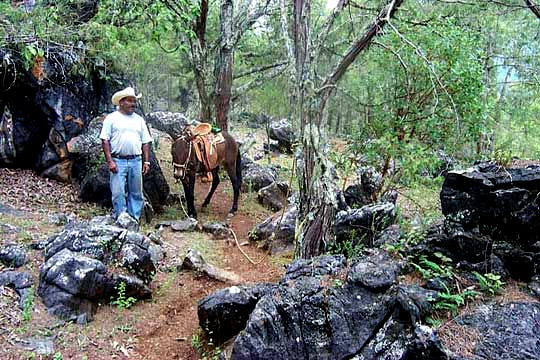Excerpts from Jim Conrad's
Naturalist Newsletter
from the August 24, 2007 Newsletter issued from Sierra Gorda Biosphere Reserve, QUERÉTARO, MÉXICO
CUTTER & PINNACLE TOPOGRAPHY
The other day I had a good hike over at Cocos (N21.3309°, W99.6551°) the little mountain town serving as a jumping-off point for visitors to Sótano de Barro, at 1312-ft-deep (400 m) one of the world's most impressive sinkholes. People at Cocos are looking for ecotour attractions to keep visitors in town after they've seen the sinkhole, and the Reserve is trying to help them.
During much of the five-hour hike I followed the crests of limestone mountains mantled with oak-juniper forest. The terrain consisted of innumerable hippopotamus-size, white limestone rocks emerging from rusty-red soil. You can see my guide, Don Marcelino, standing with his mule along a typical stretch of the trail below:

I suspect there's a good term* for describing this particular kind of karst topography (see right), karst being "An area of irregular limestone in which erosion has produced fissures, sinkholes, underground streams, and caverns."
If you start with a flat layer of exposed limestone, inevitably it'll be crisscrossed with fractures. Natural rainwater is slightly acidic, so where it enters the fractures it dissolves away the stone, eventually producing deep fissures. These fissures are called "grikes" and the flat, often rectangular slabs between them are called clints. Collectively such systems are referred to as "karren" or "lapiez."
Atop Cocos's mountains the emergent limestone is much too irregular and the spaces between the outcrops are far too wide to be called "grike & clint," or limestone pavement topography. However, I wonder if once the wide spaces might have been grikes, and the irregularly shaped rocks, clints.
Whatever the technical term for such physiography, the landscape is a pretty one to walk through, each sculptured rock expressing its own history and view of things, and the area as a whole constituting a very special ecosystem.